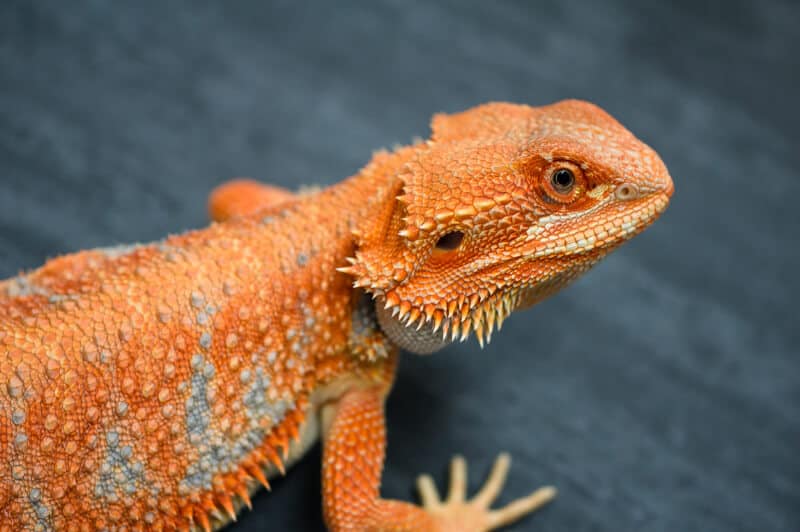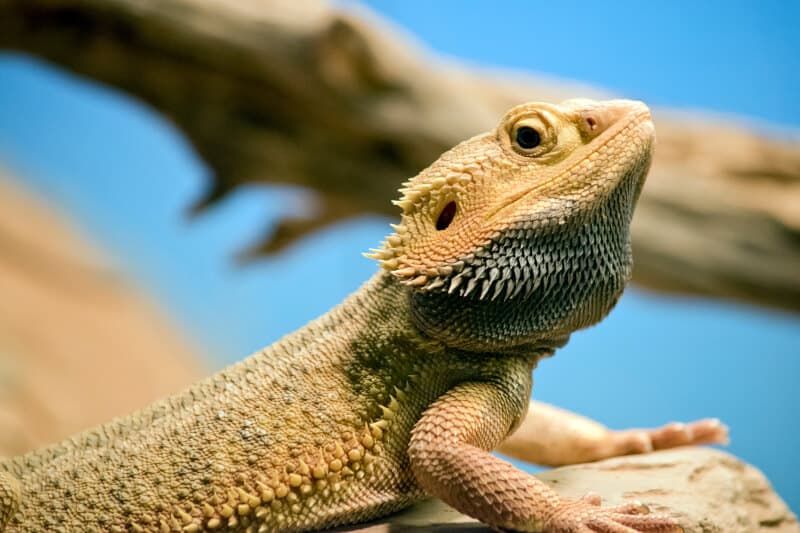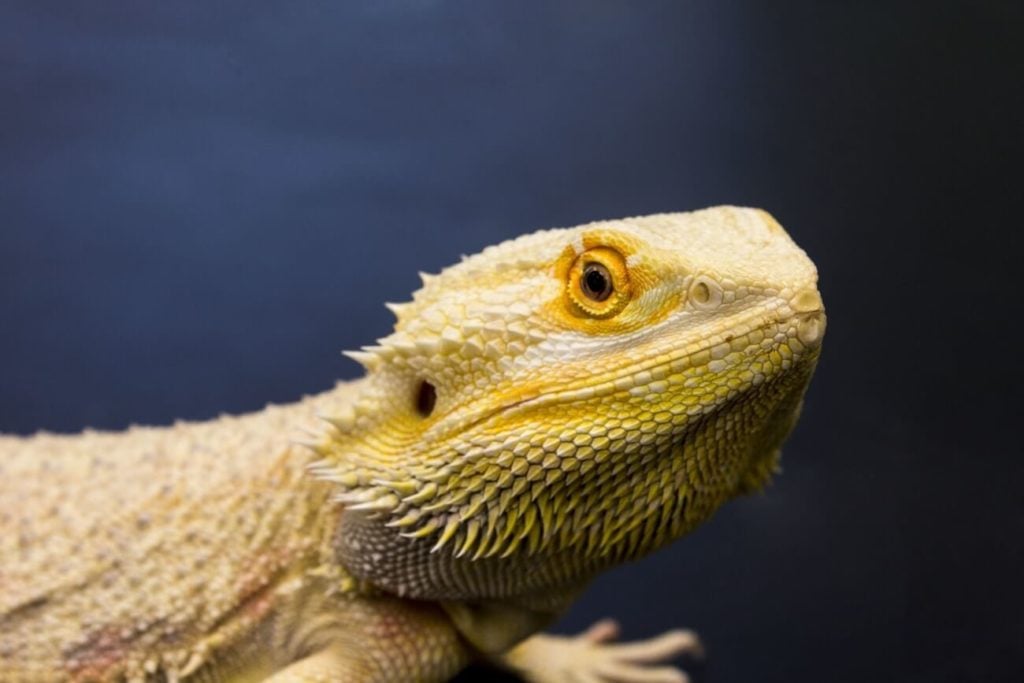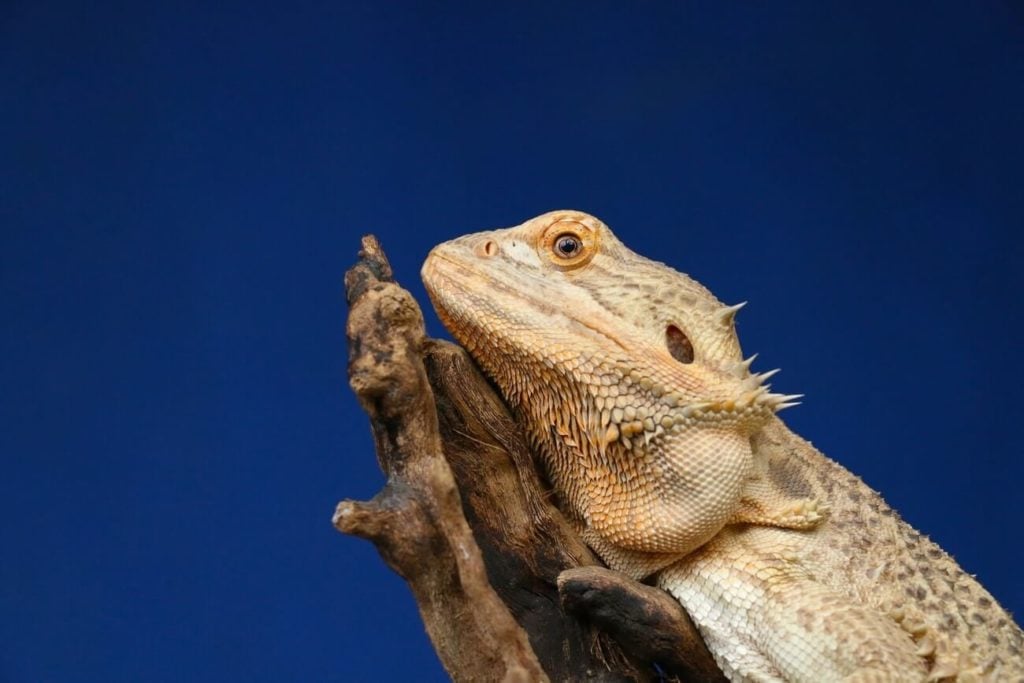Bearded dragon ears can be a bit confusing at first. Unlike other popular pets, these reptiles have a structure that’s quite different!
This guide will help you understand bearded dragon ears, and how these lizards use them to hear with great precision.
Table of Contents
Do Bearded Dragons Have Ears?
At first glance, it may seem like your bearded dragon doesn’t have ears, and this is because bearded dragons don’t possess the external ear structures that are common in many other animals.
But yes, bearded dragons do have ears.
Instead of the appearance you might be used to, your bearded dragon has an internal ear structure that is perfectly adapted to its environment and the behaviors that are needed for its survival.

Despite having an internal ear structure, bearded dragons have excellent hearing. This trait is especially important in the wild because bearded dragons need to hear even the smallest sounds that could be an indication of approaching predators, and they need to be able to locate their prey.
Because they have such sensitive hearing, it’s very important to make sure that your pet bearded dragon is given the respect and consideration that it needs in order to have a happy living environment. This means that you should never tap on the glass of its tank, and its tank should be kept far away from noisy kids, loud pets and other sounds that may cause stress or anxiety.
Where Are They And What Do They Look Like?
As we mentioned above, your bearded dragon’s ears are not external.
Instead, they are internal ears which are located in holes on the sides of their head. Imagine if you were to remove all the parts of your outer ear, including the lobe and the tragus, then you’d be left with just the opening to the middle and inner ear. This is how it is for your bearded dragon.
Many other animals, such as frogs, other lizards, snakes, and birds, have inner ears. Your bearded dragon has ears located on both sides of its head, and they can be found in an area that’s between the eye and the corner of the mouth. The things that look like big holes in the head are your bearded dragon’s ears.
Take a look inside the ears, and you’ll see something that looks like a thin piece of skin. This is the tympanic membrane and is common to all animal ears. This is a very important structure and should never be touched or punctured.
How Their Ears Are Structured Internally
The tympanic membrane is the only structure of your bearded dragon’s ear that can be seen from the outside. If you could see past this membrane, you’d find many other delicate and highly specialized structures that work in tandem with the tympanic membrane.
Working our way from the outer to the most interior portions of the ear, let’s take a brief look at some of the structures that make up your bearded dragon’s auditory system. In the next section, we’ll look at each of these structures in more detail and discuss how they work.
As you travel inside the ear, you first encounter something called the middle ear. In the middle ear you will find several structures: the tympanic membrane and a small bone that’s known as the stirrup, or stapes.
Moving further inward, the next section of the ear is the inner ear and is made up of the cochlear duct, cilia, the semicircular canal and the auditory nerves.
How Bearded Dragon Ears Work
Now that we have taken a look at the various parts of your bearded dragon’s ear, let’s see how all of these structures work together to provide these lizards with an exceptional sense of hearing.
The Tympanic Membrane
The outermost structure of the middle ear is the tympanic membrane. Most commonly known as the eardrum, this structure is made up of a thin, flexible layer of skin that vibrates whenever soundwaves strike it.
When these soundwaves travel through the air and encounter the tympanic membrane, it will vibrate and send signals to a part called the stapes.
The Stapes
The stapes, the next structure in the ear, is a very tiny bone that’s shaped like a stirrup. In terms of size, this bone may seem insignificant, but it is actually one of the most important structures in your bearded dragon’s ear. In fact, they would not be able to hear very well without it.
It’s through the stapes that information, in the form of waves, gets transmitted to the inner ear. The stapes picks up vibrations from the tympanic membrane and passes these waves along to a structure called the cochlear duct.
The Inner Ear
Once the sound vibrations leave the stapes, they enter a fluid-filled chamber that is known as the cochlear duct. This duct is full of tiny, sensitive hairs, called cilia, that pick up vibrations and send them to the auditory nerve and then to the brain.
Other Functions Of The Inner Ear
While the above structures have to do with hearing, there are other parts in the inner ear that are involved with balance. Just like with humans, balance is regulated and maintained by a bearded dragon’s inner ear. Balance is important, especially in the wild, for hunting, climbing and basic day-to-day activities.
One of the most important balance-related structures is the semicircular canal. This is another fluid and cilia-filled area of the ear that is involved with maintaining balance and detecting head movement.
When a bearded dragon moves its head, the movement of the fluid within the semicircular canal causes the cilia to move. This movement sends signals to the brain, and the brain will then send the appropriate responses necessary to maintain your beardie’s balance and orientation within its environment.
Both the left and the right semicircular canals work together to maintain your bearded dragon’s sense of balance, and the different areas of these canals provide the brain with specific information.
One part of the semicircular canal detects side-to-side head movements, another area detects up and down head movements, and another is for detecting motions that involve tilting of the head. In other words, every time your beardie moves its head, the brain receives important information that it uses to keep them balanced in every situation and posture.
Do You Need To Clean Their Ears?
Due to the nature of a bearded dragon’s ears, it’s not surprising that lots of unwanted dirt and debris ends up inside of them. As gross as this may seem to you, this is actually a pretty natural occurrence and is usually nothing to worry about.
As worrisome as it can be to find stuff inside your pet’s ear, never attempt to remove anything on your own. In the wild, what falls into their ears tends to come out by itself, and you will probably do more harm than good if you start to poke around inside your bearded dragon’s ears. The tympanic membrane, which we discussed earlier, is fairly delicate, and it may rupture if you start probing inside the ear.
You may find that your bearded dragon’s ears become clogged with shedding debris, but it’s important to let them remove this shed on its own.
If you notice that the debris in the ear is not coming out, or if there is a large object that’s stuck, take your bearded dragon to the veterinarian. A vet has the tools and experience needed to safely remove objects from their ears.
Conclusion
Now that you know more about bearded dragon ears, you’ll be able to appreciate the hearing of your pet even more. On top of that, it should make things a bit easier for you to keep them healthy and know what to do if you see anything out of the ordinary.
Let us know if you have any questions! We’re always happy to help.



